29 Top Mobile App Development Trends In 2024
Nazneen Ahmad
Posted On: February 29, 2024
![]() 76534 Views
76534 Views
![]() 16 Min Read
16 Min Read
The mobile app development industry is booming, with an increasing number of apps being developed and a growing customer base for businesses. We all rely on mobile apps for daily tasks and use them extensively.
However, have you noticed how fast it has become a quintessential part of our lives? This may be because of the evolution of the mobile app development industry seeking to develop new features and amazing mobile applications daily. Hence, the advancement in software technology, customer demand, and other related factors directly impact mobile app development trends.
To meet the needs and demands of the end-users, mobile app development is at its peak. To illustrate this, let’s take a look at some data.
- According to the Statista Digital Market Outlook, revenue across most segments of the mobile app industry is projected to reach approximately 613 billion U.S. dollars by 2027.
- The estimated annual number of app downloads globally in 2024 will project to be 299 billion.
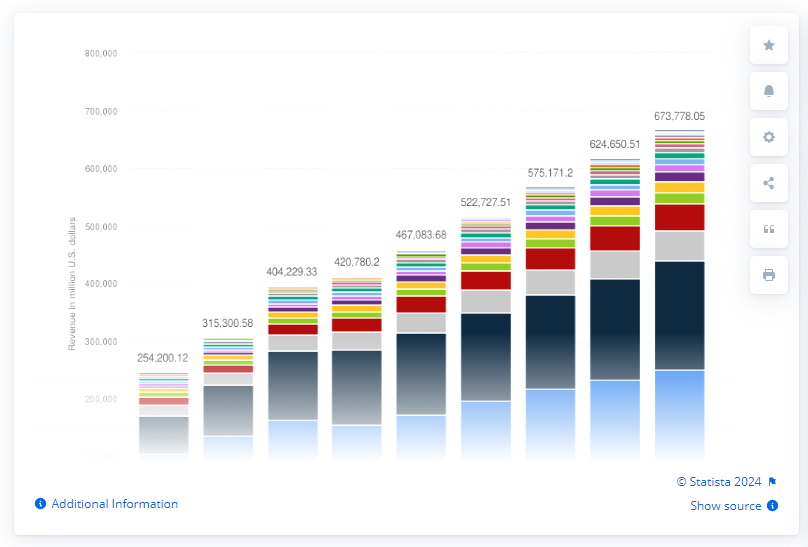
The above statistic shows the surging significance of mobile apps in developing new business opportunities. With many such apps competing for attention, making your app stand out can be challenging. To succeed in this competitive landscape, it is crucial to stay informed about the latest mobile app development trends and leverage them to create robust and feature-rich mobile applications.
One unsettling truth is that many mobile apps fail. One of the primary reasons for this is the inability to keep up with and implement the latest mobile app development trends. This deficiency often leads to losing out to more technologically adaptable competitors. However, following a few mobile app development tips can significantly improve your app’s chances of success.
For the above success, the first step is to stay updated with future mobile app development trends. With this, you can ensure that your app remains relevant and incorporates the latest advancements in the industry.
Looking at 2024, the latest amazing mobile app development trends will reinforce mobile app development and shape its future. So are you ready for mobile app development changes in recent years?
Here are the lists of top mobile app development trends.
TABLE OF CONTENTS
- Top Mobile App Development Trends
- Rise of 5G Technology
- Apps for Foldable Devices
- Internet of Things (IoT) App Integration
- Augmented Reality (AR) and Virtual Reality (VR)
- Beacon Technology
- Artificial Intelligence (AI) and Machine Learning (ML)
- Chatbots
- Wearable App Integration
- Mobile Wallet and Contactless Payments
- Cloud-Based Mobile Applications
- Cross-Platform Mobile Development
- Voice Recognition
- Mobile App Security
- Mobile Commerce
- Double Down on Motion Design
- Extended Reality (XR)
- Touchless UI
- Low code or No code
- Camera-Focused Mobile Apps
- Smart and Inclusive UX App Designs
- New Audio-Focused Social Media Platform
- Super Apps
- P2P Mobile Apps
- Instant Apps
- Blockchain Technology
- On-Demand App Development
- Predictive Analytics
- Mobile Learning
- Declarative Programming
- Conclusion
- Frequently Asked Questions (FAQs)
Top Mobile App Development Trends
Mobile app development trends refer to the prevailing and popular practices, technologies, and approaches to creating mobile applications. These trends indicate the direction in which the industry is moving and can significantly influence the development and success of mobile apps.
Staying up-to-date with these mobile app development trends is important for developers and businesses to ensure they incorporate the latest advancements and meet user expectations regarding features, functionality, and user experience.
Let’s begin to learn about the top mobile app development trends.
Rise of 5G Technology
You might have heard about the buzz surrounding 5G technology. Well, it’s a big deal for mobile app development! 5G is the next generation of mobile networks, and it brings super-fast speeds, low latency, and the ability to handle many connected devices. Statista’s report the total estimated 5G subscriptions worldwide is 1.9 billion. It is expected to increase to 2.8 and 5.9 billion in the year 2024 until 2027.
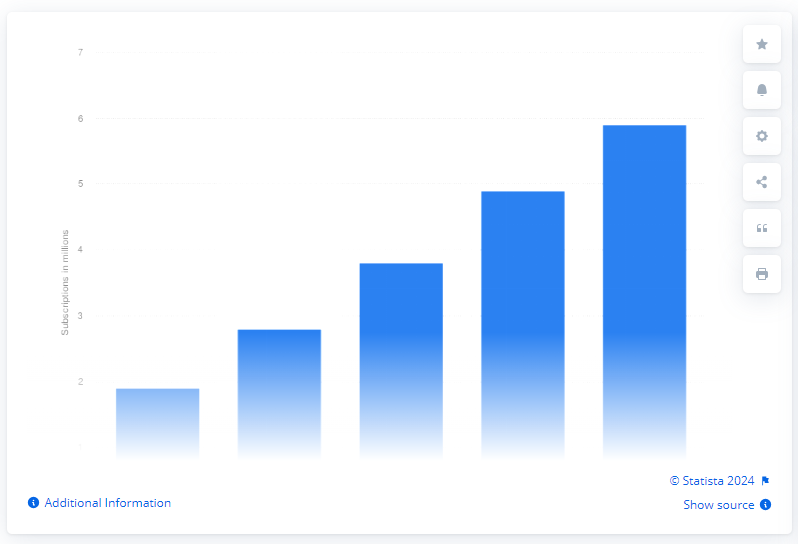
But what is the reason for such a high adoption of 5G technology? The main explanation for this is the high speed and efficiency of the network connection. It is 100x faster than 4G, and latency is lower from 50 milliseconds (4G) to 1 milliseconds. This network is being capitalized to improve app function and leverage new features like augmented and virtual reality, better cloud capabilities, fast data transfer, and enhanced live streaming.
The emergence of 5G will improve the functionality of mobile apps that will help developers to add new features to the mobile application. So, developers must use 5G’s capabilities to create awesome apps that make the most of this new technology.
Apps for Foldable Devices
Have you seen those cool foldable smartphones and tablets? They’re gaining popularity because they give you a larger screen when needed and can be easily folded for convenience. The user demand is pushing the trend of mobile app development for foldable devices in 2024.
According to the report of International Data Corporation, 48.1 million units of worldwide shipments for foldable devices with a market value of $42 Billion will reach by 2027.
In 2019, Samsung Galaxy Fold was launched in the US, and Motorola introduced the folding RAZR in the same year. Such demand will change the smartphone market share, and mobile development will be more advanced in the coming year. This shows the opportunity to develop and optimize mobile apps specifically for foldable devices.
So, when planning your mobile app development strategy, you must ensure your app runs smoothly on foldable devices giving a better user experience. However, it can be a challenging mobile app development trend in 2024. However, this innovation can be the future of mobile app development.
 Note
NoteTest your mobile apps on real Galaxy Z Fold4. Try LambdaTest Today!
Internet of Things (IoT) App Integration
The Internet of Things, or IoT for short, is not new. It is all about connecting everyday devices to the Internet and making them smart. This has become a need of our daily life as we depend on multiple devices, and each must be connected to the Internet. Further, the increasing use of mobile devices in various sectors and areas has opened up countless possibilities for the IoT.
And guess what? Mobile app developers are incorporating this technology into their mobile apps. With this, you can easily control and monitor your IoT devices using your smartphone through a single app.
According to Statista, the revenue earned by IoT-related technology is estimated to cross $1.6 trillion by 2025. Hence this indicates that there’s a lot of potential in this field.
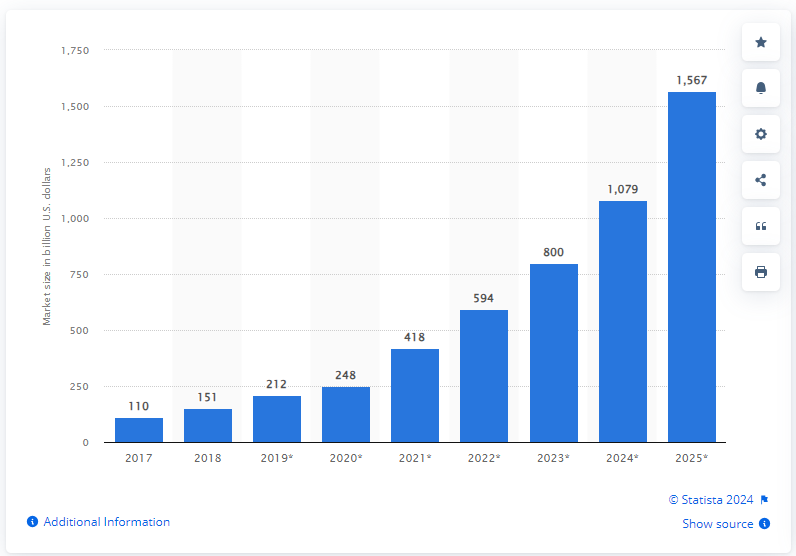
People have become habituated to using technology to enhance their daily lives. The IoT refers to the expanding network of Internet-connected devices that offer convenience and automated control to consumers. A great example is the rise of smart home technology and mobile app development.
With mobile apps, you can adjust your home’s thermostat from a different location, lock or unlock your front door, and connect to home security systems. Even household appliances like refrigerators can be connected to mobile apps.
In 2024 we anticipate a surge in mobile app development tailored to the IoT. Keep an eye on markets such as household devices, automobiles, display devices, smart devices, and healthcare. Exciting developments are expected in these areas.
Augmented Reality (AR) and Virtual Reality (VR)
Augmented Reality (AR) and Virtual Reality (VR) are also transforming the mobile app development landscape. AR technology overlays virtual elements onto the real world, enhancing user experiences and enabling applications such as virtual try-on for shopping or interactive gaming experiences. VR technology, on the other hand, immerses users in virtual environments, offering opportunities for virtual tours, virtual training, and immersive entertainment experiences.
Today, if we observe our surroundings, we can find numerous instances where brands utilize AR and VR to enhance user experiences. For example, IKEA employs AR technology to allow users to visualize how furniture will look in their homes before making a purchase. Lenskart offers a virtual try-on feature for glasses, allowing users to see their appearance before buying them.
Even tech giants like Apple, Google, and Meta are making significant strides in AR and VR. Google introduced a feature called “Live View” in Google Maps, enabling users to view directions in real-time overlaid on the real world through their camera. Another noteworthy advancement in AR technology is LiDAR, which Apple refers to as “AR at the speed of light.” This technology debuted in devices like the iPad Pro, iPhone 12 Pro, and iPhone 12 Pro Max. LiDAR has taken AR to new heights by enabling the capture of high-quality photos even in low-light conditions.
In the coming year, we can anticipate AR and VR to shape the mobile app development industry in ways that surpass our imagination. These technologies will become more mainstream in mobile app development trends, offering exciting possibilities for developers and users alike.
Beacon Technology
Have you ever wondered how some apps know where you are and provide personalized experiences based on your location? The answer is beacon technology. Beacons are small Bluetooth devices that send signals to your smartphone when you’re nearby. This opens up a whole world of possibilities for location-based services and interactions.
By detecting potential customers near your store, Beacons can help you optimize marketing campaigns and attract more clients. For instance, when someone enters a parking lot, Beacons identify their mobile app and send notifications with details about current discounts or personalized offers. This increases the likelihood of that person visiting the store and purchasing. Compared to traditional marketing channels, contactless marketing through Beacons significantly improves personalization and increases the chances of closing a sale.
Retailers can also track user behavior and create accurate maps of shoppers’ journeys within the store. This information, such as where they spend time and what products they purchase at different times, is valuable for designing effective marketing campaigns.
However, only a few organizations are leveraging the true capability of Beacons technology in their apps. In the coming time, the developer will use this technology to build apps that offer exciting aspects like location-based experiences. Considering its various benefits, it will be one of the amazing mobile app development trends.
Artificial Intelligence (AI) and Machine Learning (ML)
In 2017, Artificial Intelligence and Machine Learning were integrated into mobile app development to make it smarter. What comes to your mind when you hear about Artificial Intelligence and Machine Learning? You may think about Siri and Alexa when they are integrated into the mobile app as virtual assistance. However, we are only at the beginning stage of exploring plenty of its potential. The use of AI in mobile app development goes well beyond this.
Last year, Apple launched Core ML 3, an iOS machine-learning framework designed to help developers incorporate AI technology into their device apps. Not only this, but we also saw Google introduce new features to its Maps app, which uses AI to improve user experience. It is predicted that the market for AI will be at $190 billion at a CAGR of 37% in the given forecast period by 2025.
The advance of Artificial Intelligence and Machine Learning has encouraged the mobile app development industry to integrate different use cases like chatbots, personalized ads, etc. Features like image recognition, face detection, text and image classification, speech recognition, and others can be implemented in mobile apps.
Artificial Intelligence and Machine Learning have become one of the top mobile app development trends for 2024. In 2024, we can expect AI to reshape how apps are built, making them more intelligent, more efficient, and capable of providing richer user experiences.
Chatbots
Chatbots have become advanced and reached a peak compared to the early days of AOL Instant Messenger. Now, they have evolved mainly in the realm of customer service on their website.
While only a small fraction of apps on the Apple App Store and Google Play Store currently utilize chatbots, there is an expectation that this will change in 2024. The demand for chatbot-driven interactions is on the rise, and advancements in AI technology are making chatbot responses more natural and human-like.
The Global Chatbot Market is witnessing significant growth and is expected to grow at the Compound Annual Growth Rate (CAGR) of 23.3% from 2024 to 2030. Chatbots must be more widely integrated into mobile app development to achieve broader usage.
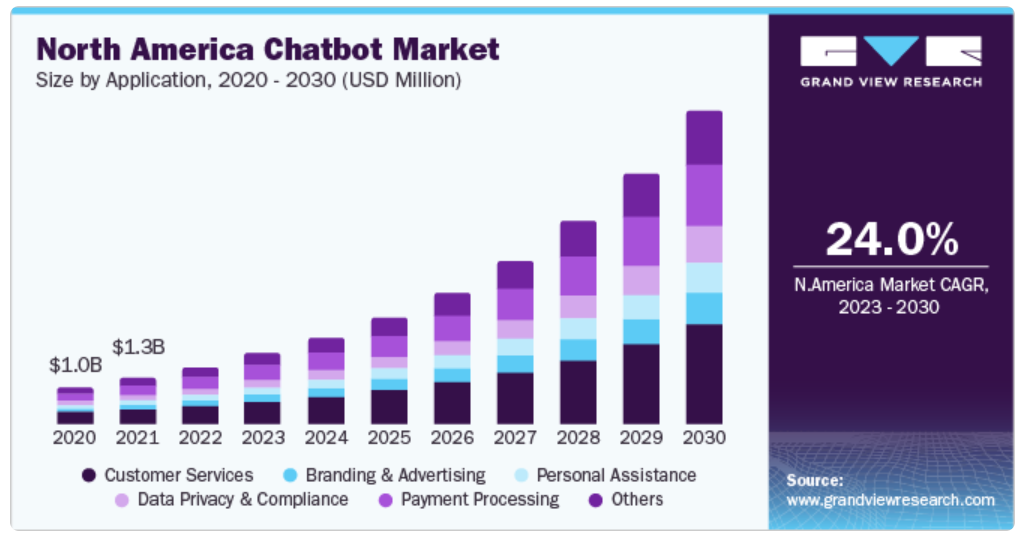
As AI technology advances, we can anticipate seeing chatbots becoming increasingly prevalent across various applications, including mobile apps. This will lead to improved customer experiences and more efficient support services.
Wearable App Integration
Wearable devices are becoming popular day by day and greatly impact the world, with the presence of smartwatches, trackers, and fitness bands becoming increasingly common. According to Statista, the total number of connected wearable devices worldwide increased to 1.1 billion from the 929 million recorded the previous year.
In 2019, Apple made a significant announcement regarding wearables and app integration at WWDC. The introduction of watchOS 6 brought the Apple App Store directly to the Apple Watch, enabling the development of independent apps specifically for these devices. Google launched unified wearable platforms that combine its wear operating system with Samsung’s Tizen software platform. This collaboration resulted in a significant boost in app startup times.
These advancements signify the growing influence of wearable technology, making it one of the key mobile app development trends for 2024. In other words, app developers and businesses should prepare themselves to create apps that offer a superb digital experience to users on smartwatches and other wearable devices. By doing so, they can gain a competitive advantage over those who neglect this trend.
Mobile Wallet and Contactless Payments
Mobile app development is constantly evolving, and one of the prominent mobile app development trends in this field is the growing emphasis on mobile payments within eCommerce.
The eCommerce market is experiencing rapid growth worldwide, and mobile shopping has become increasingly popular among consumers. As a result, there is a rising demand for convenient and secure mobile payment solutions. In 2024, it is expected that there will be 1.31 billion mobile payment transaction users worldwide.
Alongside traditional banking apps, several widely-used payment apps, such as Apple Pay, Google Pay, PayPal, AliPay, WeChatPay, and Zelle, have gained popularity. These applications empower users to perform financial transactions swiftly, easily, and from anywhere, contributing to the rapid growth of mobile commerce. QR codes have become particularly popular for contactless payments. Many mobile payment apps and platforms utilize QR codes to facilitate transactions.
In the coming years, the development of eCommerce apps that integrate mobile payment functionality is expected to continue as a significant trend in mobile app development. Businesses and app developers recognize the importance of providing seamless and secure mobile payment experiences to cater to the increasing number of consumers who prefer to shop and transact through their mobile devices.
By staying up-to-date with this trend and incorporating mobile payment capabilities into their eCommerce apps, businesses can enhance customer convenience, attract a wider user base, and remain competitive in the ever-evolving mobile app landscape.
Cloud-Based Mobile Applications
Apps incorporating advanced technologies like Artificial Intelligence, Machine Learning, and the Internet of Things often require significant storage in a mobile device’s internal memory. However, users prefer not to install large gigabyte-sized apps on their devices.
Fortunately, cloud computing offers an effective solution to this problem. By utilizing remote servers, apps can leverage the necessary storage space without impacting the limited internal memory of a mobile device. In 2024, the cloud-based mobile app is the latest trend, and more focus is being paid to its development.
The cloud-based mobile application provides secure functionality across multiple devices, increased computing power, improved storage, and loading capacity, and streamlined operations. Due to these advantages, more providers are actively investing in developing cloud-driven apps. This trend has emerged in the era of cloud mobile computing, where the power and capabilities of the cloud are harnessed to deliver innovative and efficient mobile app experiences.
Cross-Platform Mobile Development
Android and iOS are the dominant mobile app operating systems, estimated at 67.56% and 31.60% of the market share. People in the mobile application widely use these OS, and due to this, it is most cost-effective for the business to build cross-platform apps which can run on both Android and iOS devices.
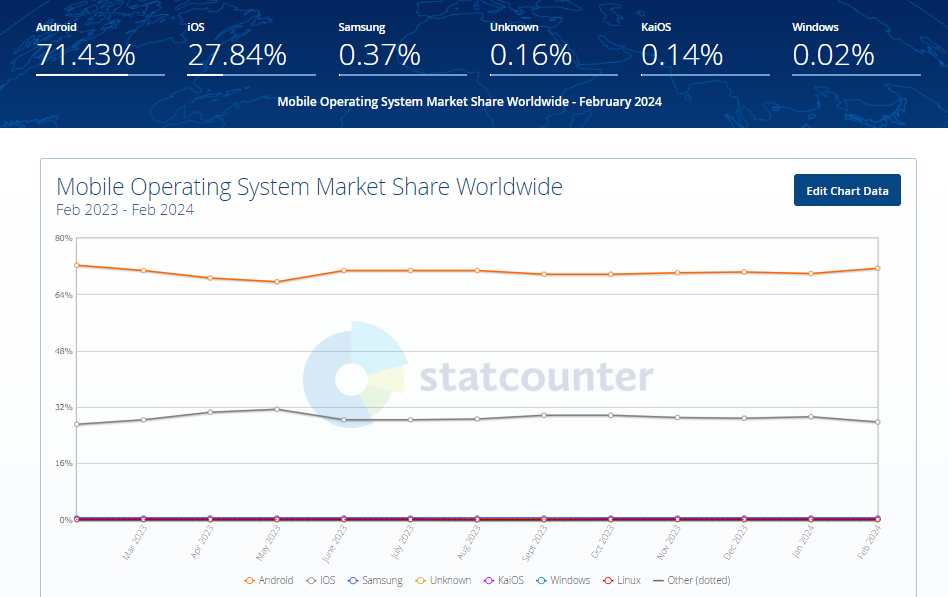
Cross-platform mobile app development has become one of the latest mobile app development trends; however, it exists way back. The rise in this mobile app development trend is because of the users’ preferences and inclination towards such apps. It offers several advantages to businesses, including the ability to reach a larger audience, reduce development time, and optimize costs for launching the app. They can also ensure that all users can access the mobile app developed.
The mobile app can be tested in a cloud-based platform like LambdaTest to leverage its true capability. LambdaTest is an AI-powered test orchestration and execution platform that lets you run manual and automated tests at scale with over 3000+ real devices, browsers and OS combinations. This will help you perform mobile app testing to ensure that your app functions correctly and appears as intended on various mobile devices.
It also gives access to a vast library of real mobile devices. This means the developed mobile app can be tested on a real device cloud. With this, you can test your app on various smartphones and tablets to ensure compatibility, responsiveness, and performance across different screen sizes, resolutions, and hardware configurations.
This opens opportunities to engage more users, expand the app’s reach, and achieve better business outcomes. Ensure your website’s mobile responsiveness with LambdaTest’s mobile-friendly test, a handy tool to optimize your user experience.
Subscribe to our LambdaTest YouTube Channel to get the latest updates on mobile testing tutorials around Appium, App Automation, and more.
Voice Recognition
According to the Voice Recognition Market there is incredibly popular and addictive among users. Unsurprisingly, the voice search market will reach nearly $42.08 billion U.S. by 2029.

Businesses from various industries have recognized the significance of voice search and are actively incorporating it into their apps.
They understand that integrating voice search functionality enhances the user experience, making their apps more appealing and user-friendly.
You can simply speak their queries or commands with voice search instead of typing them. This level of convenience and accessibility has transformed how we interact with apps and software technology.
Businesses’ growing adoption of voice search indicates its importance in meeting user needs and preferences. By embracing voice search, organizations provide users with a seamless and effortless way to interact with their apps.
Mobile App Security
Mobile devices face a significant security threat and are vulnerable to various attacks. Also, Statista reported that in 2022 the malware attack crossed 5.5 billion worldwide, and a 2% increase is expected in 2024. A survey showed that nearly 45% of iOS and Android users would stop and discourage others from using an app they deemed insecure.
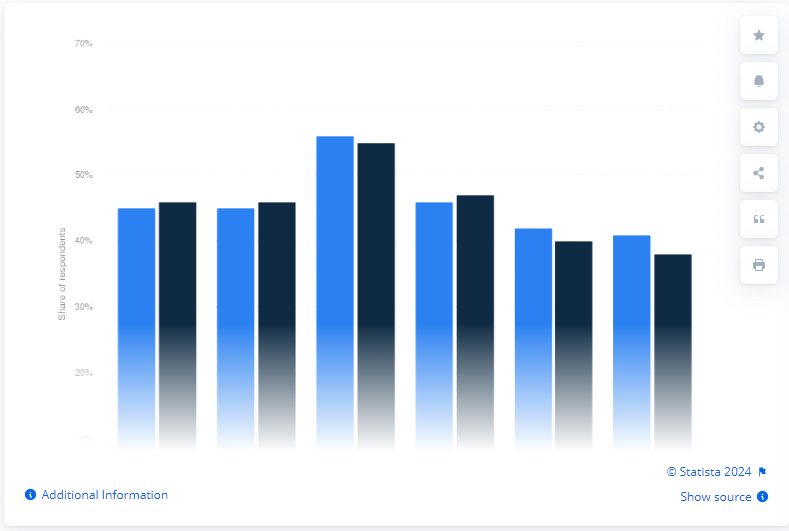
As people depend on mobile apps, organizations focus more on cybersecurity and seek to develop mobile apps with robust data protection and information privacy laws. Thorough testing during app development is essential to identify and fix vulnerabilities, as customer trust is at stake.
Hence, focusing on improving mobile app security is the trend, and developers seek to implement a feature like Sign in With Apple.
Incorporating biometric logins, such as fingerprint or facial scans, adds an extra layer of security. Mobile app developers should prioritize app security in 2024 to build trust and ensure long-term success. In 2024, it is expected a shift to a security-first approach and thus lays a roadmap for a robust DevOps strategy.
Mobile Commerce
Mobile commerce is a dominant trend that has been thriving in 2021 and 2022, and it will continue to be significant in 2024. Organizations of all sizes, including retailers, content creators, and personal brands, seek to develop mobile apps to increase revenue by initiating the selling and purchasing of goods. This mobile eCommerce functionality has become the primary feature that app resellers highlight in client pitches.
The competition in the online selling space is extreme, and having a mobile commerce app is becoming essential to stay competitive. Every new eCommerce organization competes with giants like Amazon and Flipkart and starts taking over the business offline.
In 2024, eCommerce sales exceeded 5.7 trillion U.S. dollars worldwide. We expect that such sales will reach a great height in the coming year. Such high eCommerce sales were only possible through mobile devices, thus focusing on the significance of apps in the success of mobile commerce. eCommerce app development will continue to be a major focus in 2027.
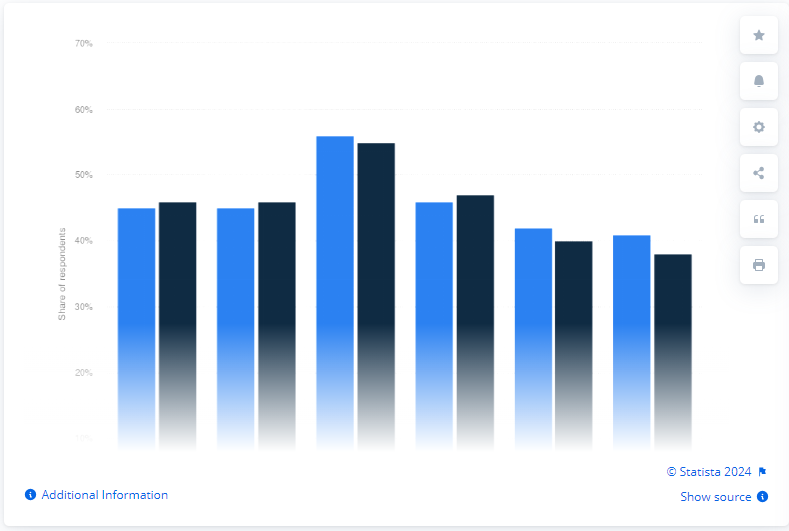
Double Down on Motion Design
Mobile apps’ complex or steady design can disengage users and make them feel bored. To enhance user engagement and create a remarkable experience, it is recommended to focus on motion design in your app. Motion design, on the other hand, grabs the user’s attention and encourages interactivity. Incorporating motion design icons, animated scrolling, and macro interactions can improve user engagement.
Appinventiv, for example, successfully integrated refined motion design features in Domino’s app, resulting in a significant 23% increase in conversion rate. Additionally, app motion design features help save users’ time by guiding them through a seamless experience. The software industry will follow this mobile app development trend will be followed by the software industry and seek to incorporate motion design in mobile apps.
Extended Reality (XR)
Extended Reality (XR) technology, including augmented reality (AR) and virtual reality (VR), is gaining popularity in mobile apps. AR filters and gaming interfaces, like the popular game Pokémon Go, showcase the use of XR in mobile applications. Additionally, major enterprises have started leveraging XR for virtual training and onboarding processes.
According to Statista’s prediction, the revenue in the Extended Reality market is expected to reach $52 billion by 2027. AR and VR have already been widely accepted as new business marketing strategies. This enables product owners to introduce and enhance their services using XR, attracting maximum attention and boosting conversions. This mobile app development trend in 2024 will boost user experience.
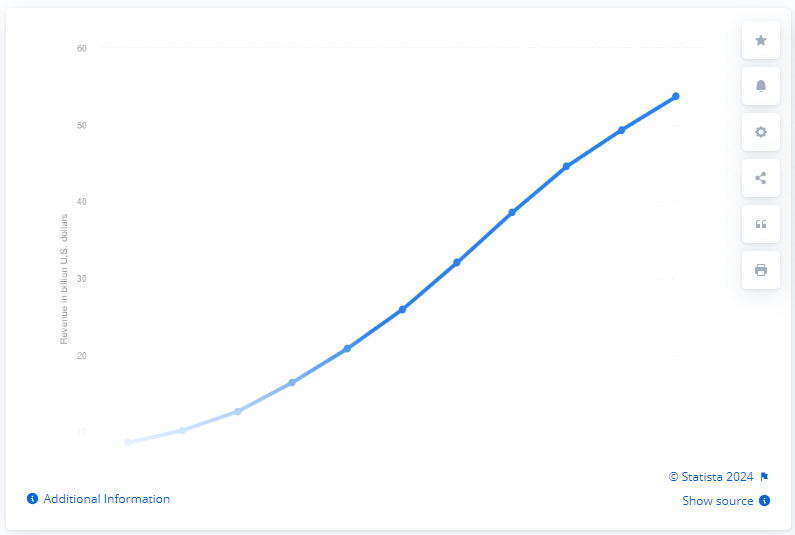
Touchless UI
Touchless UI is a tremendously growing trend in mobile app development. It allows you to interact with mobile applications without physically touching the screen. With the use of software technologies such as voice recognition, gesture control, and facial recognition, touchless UI offers a convenient user experience. Gartner predicts that by 2024, more than 50% of major business apps will incorporate touchless experiences.
While users are already familiar with touchless UI features like biometric authentication, such as fingerprints or facial recognition, finance and payment apps often employ these as a double authentication factor. Additionally, upcoming mobile apps may track eye movements to assist with scrolling.
The future of app design and development holds exciting transformations, ranging from simplified designs to trending AR/VR interfaces. These innovative approaches are set to become prominent in mobile app development trends.
Low code or No code
Low or no code movement is a significant trend in the mobile app market. It empowers individuals with limited coding expertise to create mobile applications using visual interfaces and pre-built components. It offers developers shortcuts and tools to create interactive applications in less time. For instance, Zapier enables plug-and-play interactions with various services and features.
Bubble is another website that assists non-technical designers and business owners in building complete web apps. You will be surprised to know that the global low-code platform market will reach 65 Billion U.S. dollars by 2027 – Statista.
These platforms provide drag-and-drop functionality, pre-defined templates, and easy-to-use tools for designing and configuring app functionalities. This mobile app development trend can enable faster app development cycles, reduce costs, and encourage innovation by facilitating non-technical users to bring their app ideas to life. It can democratize app development and opens up new opportunities for individuals and businesses alike.
Camera-Focused Mobile Apps
Camera-focused mobile apps are gaining speed as a significant mobile app development trend. With smartphone cameras’ increasing quality and capabilities, developers are leveraging this technology to create innovative and amazing applications. These apps are designed to enhance user experiences by utilizing the camera as a central feature.
Businesses are inclined towards video conference app development due to the rise of remote working culture. This has led to an increase in their revenue by enabling broadcasting, the creation of social networks, etc.
More attention will be given to camera-focused mobile apps for streaming entertainment, broadcasting, and social media networking niches in the coming year. This trend taps into the growing demand for visually-driven applications, empowering users to unleash their creativity and explore new dimensions of mobile photography and videography.
Test your Camera image captures on real devices.Try LambdaTest Now!
Smart and Inclusive UX App Designs
One of the emerging mobile app development trends is smart and inclusive UX app designs that leverage AI and ML to customize app interactions and give tailored recommendations. These days, inclusive UX allows apps are being focused so that it becomes easily accessible to users with impairments and uses features like voice commands and adaptable interfaces.
A notable example is the survival game “Rust,” which gained significant attention by randomizing players’ skin colors. By ensuring that your app design caters to a diverse range of demographics, you can effectively engage and satisfy your app users.
New Audio-Focused Social Media Platform
Another new trend in mobile app development is the rise of audio-focused social media platforms. While video and camera-based social media apps are gaining popularity, it’s important not to overlook the significance of the traditional audio-based format in the social space. A prime example is Clubhouse, an audio-based conversational social media app boasting over 10 million active users.
Clubhouse offers users a spontaneous experience, enabling them to join ongoing conversations in various chat rooms seamlessly. This innovative voice-based app has experienced exceptional growth, with a 100% increase in users over the past four years. This highlights that the audio format is more than just a mobile app development trend within social media apps; it has become a meta-trend with broader implications.
Super Apps
In 2024, the creation of super apps is expected to be a significant trend in the software technology industry. To your knowledge, super apps are ecosystems of applications that are seamlessly integrated, offering users a wide range of core features along with access to independently developed mini-apps.
Now, organizations are inclined toward single-purpose apps as one-stop solutions for most issues. One most interesting example is Natural AI which changes the interaction approach of people with their phones and helps them solve multiple problems with a single app. You must have witnessed how Facebook has extended from being a social media platform to a marketplace. Similarly, with Amazon, you can also purchase goods and pay bills.
This will be one of the major mobile app development trends in 2024. The focus will be on the super app, designed and built to assist end users, whether customers, partners, or employees, by providing a comprehensive set of functionalities within a single application.
P2P Mobile Apps
P2P (peer-to-peer) mobile apps are gaining attention and have emerged as a prominent trend in mobile app development. Such an app helps direct transactions and communication with users, waiving any intermediaries’ requirements. Using such an app allows you to have peer-to-peer payments, file sharing, and a collaborative marketplace at one point.
In 2024, the leverage of secure and efficient technologies can allow you to have a seamless experience that empowers you to connect and conduct transactions directly with one another. Hence, this market will expand more in the future and rise as mobile app development trends.
Instant Apps
Instant apps are one of the emerging mobile app development trends that helps us to access and use certain app functionalities without the need to install the complete app on our device. In other words, such apps need not be downloaded on your phone for use, and you can access them directly.
But how can this be done? Developers use Android Studio to develop an instant app that can be tried without installation. You just have to click on the Try Now button.
Although it was launched a year back, its usage and development can be witnessed in the coming time. For example, a commerce app known as Hollar increased their conversion and Android traffic by 20% and 30%, respectively, from its instant apps. However, it has size restrictions and may not be available in the full app version. In the coming time, such a limitation can be fixed.
So, if you are thinking of launching an app in Google Play Store in 2024, you should definitely have its instant version.
Blockchain Technology
Blockchain technology is revolutionizing various industries and is a prominent trend in mobile app development. Utilizing a decentralized and secure network, blockchain enables transparent and tamper-proof transactions and data storage. Mobile apps are integrating blockchain technology to enhance security, streamline processes, and provide trust and transparency to users.
Blockchain-based mobile apps offer immutability, traceability, and data integrity benefits. They can be utilized in areas like supply chain management, finance, healthcare, and voting systems, to name a few. By leveraging blockchain, mobile apps transform traditional systems by removing intermediaries, reducing fraud, and increasing efficiency.
Blockchain technology in the mobile app development trend is paving the way for a more secure and decentralized digital future.
On-Demand App Development
On-demand app development refers to creating mobile applications that cater to immediate or real-time needs. These apps are designed to provide instant access to services or products whenever users require them. Examples of on-demand apps include food delivery services like Uber Eats or ride-sharing platforms like Uber or Lyft.
After the lockdown, people began relying on food and Grocery delivery apps. These two then rose heavily and became one of the fastest-growing apps over the years. The dependency on such apps is increasing daily, no matter whether we have returned to normal situations. These apps help us easily order food and other items and deliver them to our doorstep. It is expected to have a $320 billion market size in the food delivery app industry by 2029. This data shows that the organization will focus on on-demand apps to earn revenue in the coming time, and many new such apps will be developed.
However, on-demand apps are still trending; in the coming time, they will be leveraged with new features and options. Its development in the future will focus on creating intuitive interfaces, robust backend systems, and efficient logistics to ensure smooth and quick service delivery.
Predictive Analytics
Predictive analytics has been a valuable tool for enterprises in mobile app development for quite some time. Let’s take examples of Netflix and Amazon to understand how it works. Netflix uses predictive analytics to recommend movies and TV shows based on the user’s habit of watching movies. Similarly, Amazon also uses it to personalize product suggestions.
In 2024, predictive analytics will become even more prevalent in mobile app development. Here are two areas where we anticipate the trend will have a significant impact:
- Enterprises can utilize predictive analytics to analyze the data gathered from developers during the app development lifecycle. The focus shifts towards delivering innovations and improvements rather than dealing with unforeseen problems.
- Businesses can leverage user data obtained from mobile apps to predict user actions and personalize their journey within the app.
Predictive analytics will be incorporated into apps, and such mobile app development trends will make a huge difference.
Mobile Learning
Mobile learning is very popular, and in the future, it will become the approach to education. The mobile learning market is projected to reach a substantial value of $58.50 billion by 2029, with a Compound Annual Growth Rate (CAGR) of 21.45% from 2024 to 2029.
Mobile learning has gained popularity due to several effective reasons. Firstly, it offers the advantage of accessibility, allowing you to access educational content anytime and from anywhere. Moreover, mobile learning has introduced interactive and enjoyable learning experiences through features like continuous feedback and 360-degree learning. These aspects make learning more engaging, interactive, and enjoyable for learners.
Considering the high demand for mobile learning apps and the potential benefits they offer, now is an opportune time to explore the development of a mobile learning solution. Whether you have a groundbreaking idea or a plan to launch a mobile learning platform to train your employees, you should reach out to a specialized team experienced in education app development. They can help you bring your vision to life and create a valuable mobile learning app that meets your organization’s unique needs.
Intrigued to know about mobile application testing, check our detailed mobile app testing tutorial and learn how to unearth bugs and optimize your mobile apps.
Declarative Programming
Declarative programming brings some great benefits to mobile app development. For one, it simplifies things and makes us more productive. We can achieve the same functionality with less code, which means fewer chances of making mistakes. It also makes the code easier to read and understand, making it simpler to maintain and update in the future.
So, instead of writing step-by-step instructions, we define the end goal or the desired state of the app and let the underlying tools and frameworks take care of the actual coding. It’s like telling the computer what we want, and it figures out the best way to make it happen. Thus, based on its offering, we expect a growth in popularity in the coming year.
Conclusion
The mobile app industry is continuously evolving, and 2023 will bring new mobile app development trends or leverage the existing ones with exciting add-ons. They need to stay updated on the latest trends. This ultimately enhances our experience and helps businesses to stay ahead of the competition in the mobile app market.
Whether integrating AI and AR, adopting cross-platform development, prioritizing security and privacy, exploring PWAs, or embracing declarative programming, following these mobile app development trends will help developers and businesses create innovative, user-centric, and successful mobile applications in the ever-evolving digital landscape.
To further strengthen your expertise in mobile app development and mobile testing, be sure to check out our comprehensive guide on top asked mobile testing interview questions. This resource will equip you with the knowledge needed to excel in this dynamic field.
Frequently Asked Questions (FAQs)
How can developers incorporate Artificial Intelligence (AI) into mobile app development?
You can integrate AI-powered chatbots to improve and optimize user interaction and communication for a personalized experience. You can also leverage Machine Learning algorithms to evaluate user data and provide customized content or suggestions.
What role do cross-platform development platforms play in mobile app development trends?
Cross-platform development platforms like LambdaTest help you test apps that can run on multiple mobile OS like Android and iOS.
How can mobile app developers address security and privacy concerns?
You can implement secure coding practices like encryption of sensitive data. You can also integrate secure authentication methods like biometrics, improving app security.
Got Questions? Drop them on LambdaTest Community. Visit now













